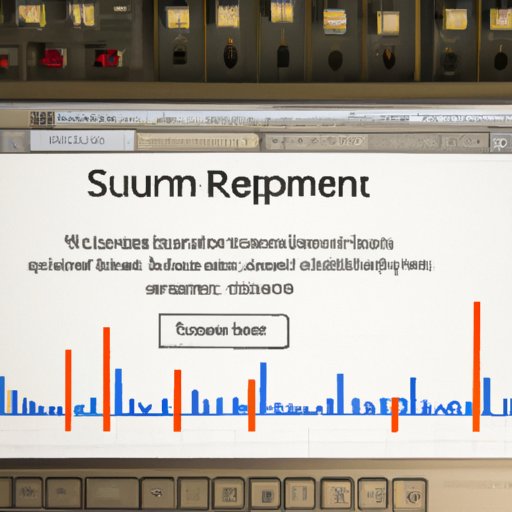Introduction
Sample rate in audio refers to the number of samples per second used to represent audio recordings. It determines the quality of sound recordings and can have a significant impact on audio production. In this article, we will explore what sample rate is in audio and how it affects the quality of audio recordings and productions.

Explaining the Basics of Sample Rate in Audio
In order to understand what sample rate is in audio, we must first define it. Sample rate is the number of samples of audio taken per second to represent a sound. The higher the sample rate, the better the quality of the recording. For example, a sample rate of 44100 Hz (Hertz) means that 44100 samples per second are taken to represent the audio recording.
How sample rate affects audio quality is determined by the frequency range of the recording. Higher sample rates produce better audio quality because they allow for a wider frequency range. For instance, if a recording is made at a sample rate of 44100 Hz, the frequency range of the recording will be significantly wider than a recording made at a sample rate of 22050 Hz. This difference in frequency range results in a noticeable difference in audio quality between the two recordings.
Sample Rate: A Beginner’s Guide to Understanding Audio Quality
When it comes to understanding audio quality, there are several different types of sample rates that can be used. These include CD quality (44100 Hz), DVD quality (48000 Hz), High Definition Audio (96000 Hz) and Ultra High Definition Audio (192000 Hz). Each type of sample rate has its own advantages and disadvantages when it comes to audio quality.
CD quality, or 44100 Hz, is the most commonly used sample rate for audio recordings. It is widely considered to be the standard for audio quality, as it provides a good balance between audio fidelity and file size. However, it does not provide the highest level of audio fidelity available.
DVD quality, or 48000 Hz, is the next step up from CD quality. It offers a slightly higher level of audio fidelity than CD quality but does require larger file sizes. High Definition Audio, or 96000 Hz, provides the highest level of audio fidelity available and requires much larger file sizes than CD or DVD quality.
Ultra High Definition Audio, or 192000 Hz, is the highest sample rate available and provides an even higher level of audio fidelity than High Definition Audio. However, it requires extremely large file sizes and is not suitable for all audio applications.
The Impact of Sample Rate on the Quality of Your Audio Productions
When it comes to choosing a sample rate for your audio recordings and productions, there are several factors to consider. The most important factor is the desired audio quality. If you are looking for the highest level of audio fidelity, then you should opt for a higher sample rate such as 96000 Hz or 192000 Hz. However, if you are looking for a good balance between audio fidelity and file size, then you should opt for a lower sample rate such as 44100 Hz or 48000 Hz.
It is also important to consider the type of audio production you are working on. For example, if you are producing music for streaming services, then you should opt for a lower sample rate such as 44100 Hz or 48000 Hz. On the other hand, if you are producing audio for video games or film, then you should opt for a higher sample rate such as 96000 Hz or 192000 Hz.
Finally, it is important to compare different sample rates and their impact on audio quality. While a higher sample rate may offer better audio fidelity, it may also require larger file sizes which could affect the overall performance of your audio production. Therefore, it is important to compare different sample rates and their impact on audio quality before making a decision.
Conclusion
In conclusion, sample rate is an important factor in determining the quality of audio recordings and productions. By understanding what sample rate is in audio and how it affects audio quality, you can make an informed decision when choosing a sample rate for your audio recordings and productions. Knowing the differences between different sample rates and their impact on audio quality will help you ensure that you are getting the best possible audio quality for your audio productions.
We hope this article has helped you gain a better understanding of sample rate in audio and how it affects audio quality. Remember to always compare different sample rates and their impact on audio quality before making a decision.
Summary
This article explored what sample rate is in audio and how it affects audio quality. We discussed the different types of sample rates and how they impact audio quality. We also discussed the factors to consider when choosing a sample rate for audio recordings and productions. Finally, we looked at how to compare different sample rates and their impact on audio quality.
Final Remarks
Sample rate is an important factor in determining the quality of audio recordings and productions. By understanding what sample rate is in audio and how it affects audio quality, you can make an informed decision when choosing a sample rate for your audio recordings and productions.


